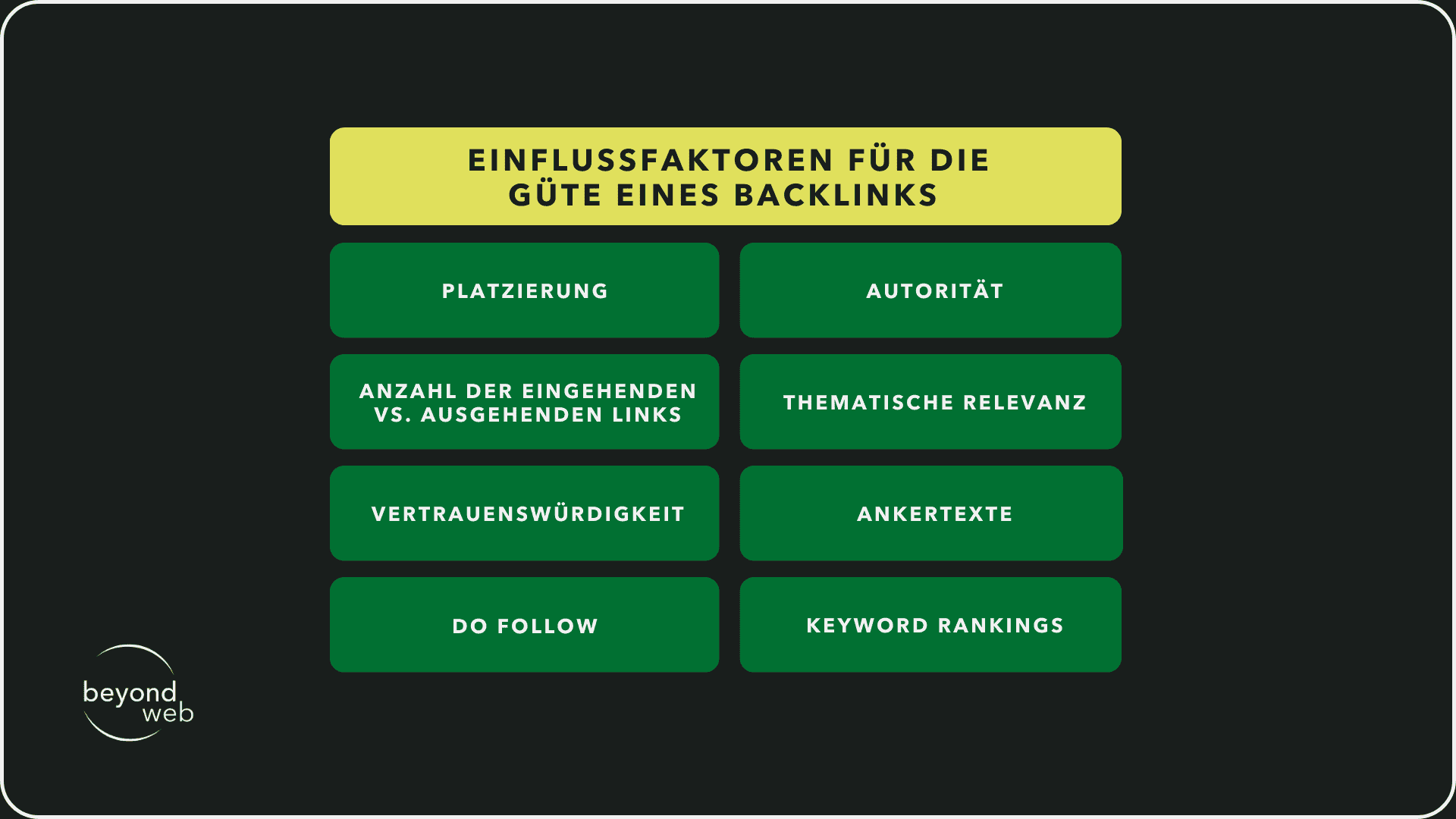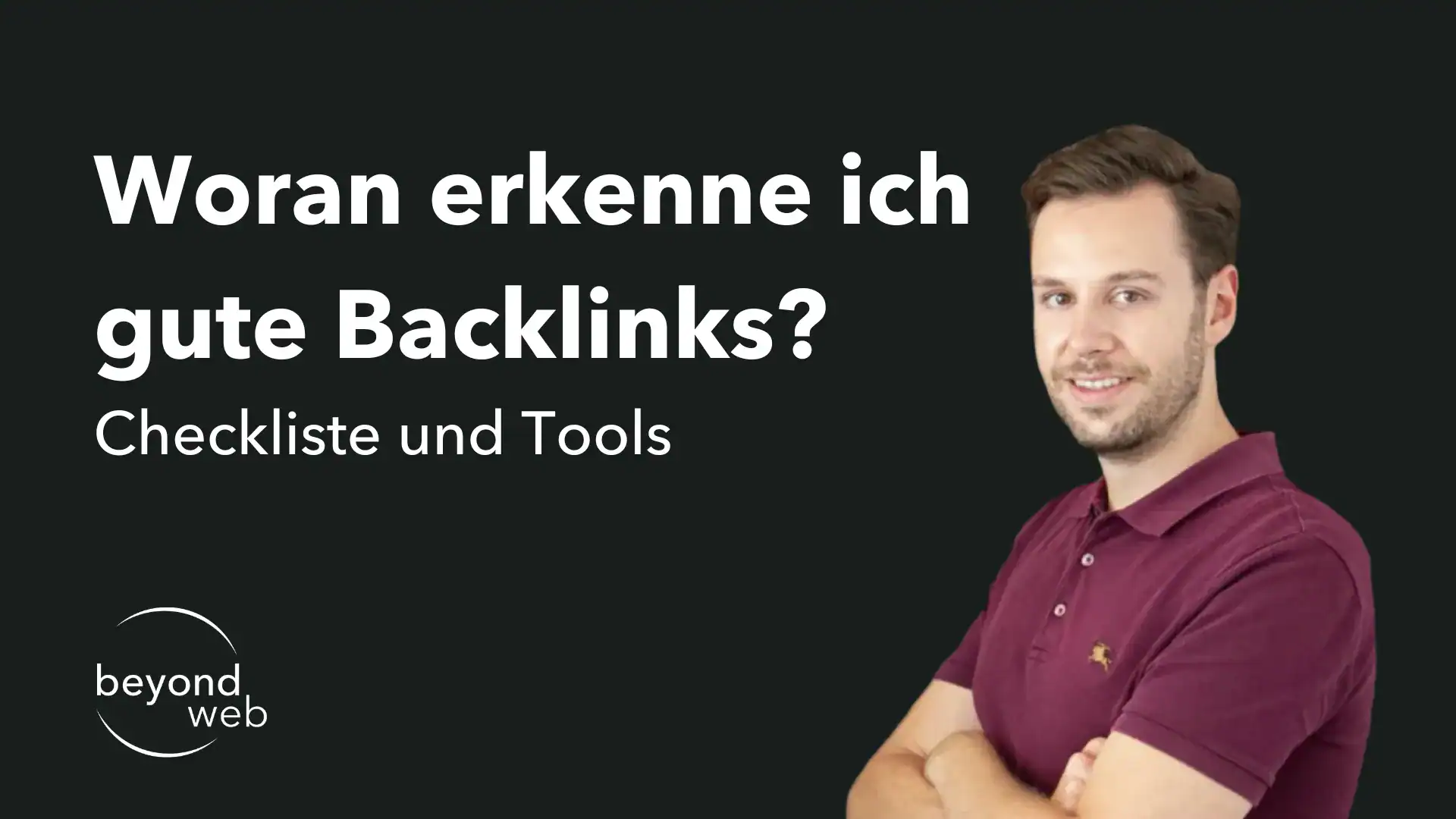Praktische Checkliste (inkl. Tools) für den Backlink-Check
Gute Backlinks sind von verschiedenen Faktoren abhängig.
Damit diese Faktoren verständlich werden, haben wir eine Checkliste inklusive Tools für den Backlink-Ckeck erstellt.
Im folgenden Abschnitt werde ich die einzelnen Punkte Schritt für Schritt erklären:
1. Wo wurde der Backlink auf der Website eingefügt?
Die Platzierung von Backlinks auf einer Website ist ein wichtiger Aspekt.
Der Ort, an dem ein Backlink auf einer Webseite platziert wird, kann einen signifikanten Einfluss darauf haben, wie Suchmaschinen diesen Link bewerten und welche Wertigkeit er aufweist.
Startseite vs. Unterseiten
Backlinks, die direkt auf der Startseite einer Website platziert werden, gelten oft als besonders wertvoll.
Das liegt daran, dass die Homepage, also die Startseite, in der Regel die Seite mit dem höchsten Traffic und der stärksten Autorität innerhalb einer Domain ist.
Ein Link von der Startseite wird deshalb in der Regel von Suchmaschinen als starkes Empfehlungssignal gewertet.
Ausserdem ist es wahrscheinlicher, dass mehr Besucher den Link sehen und darauf klicken, was zusätzlichen Traffic generieren kann, was von Suchmaschinen wiederum ebenfalls als positives Signal gewertet wird.
Ein Backlink, der auf einer Unterseite platziert wird, ist hingegen deutlich weniger wert.
Unterseiten haben innerhalb einer Domain eine geringere Autorität, die sie vererben können.
Zusätzlich werden Links auf Unterseiten von Websitebesuchern schlichtweg seltener gesehen und generieren dadurch weniger Traffic auf die Zielseite.
Links auf Unterseiten werden von der Suchmaschine dementsprechend weniger stark eingestuft.
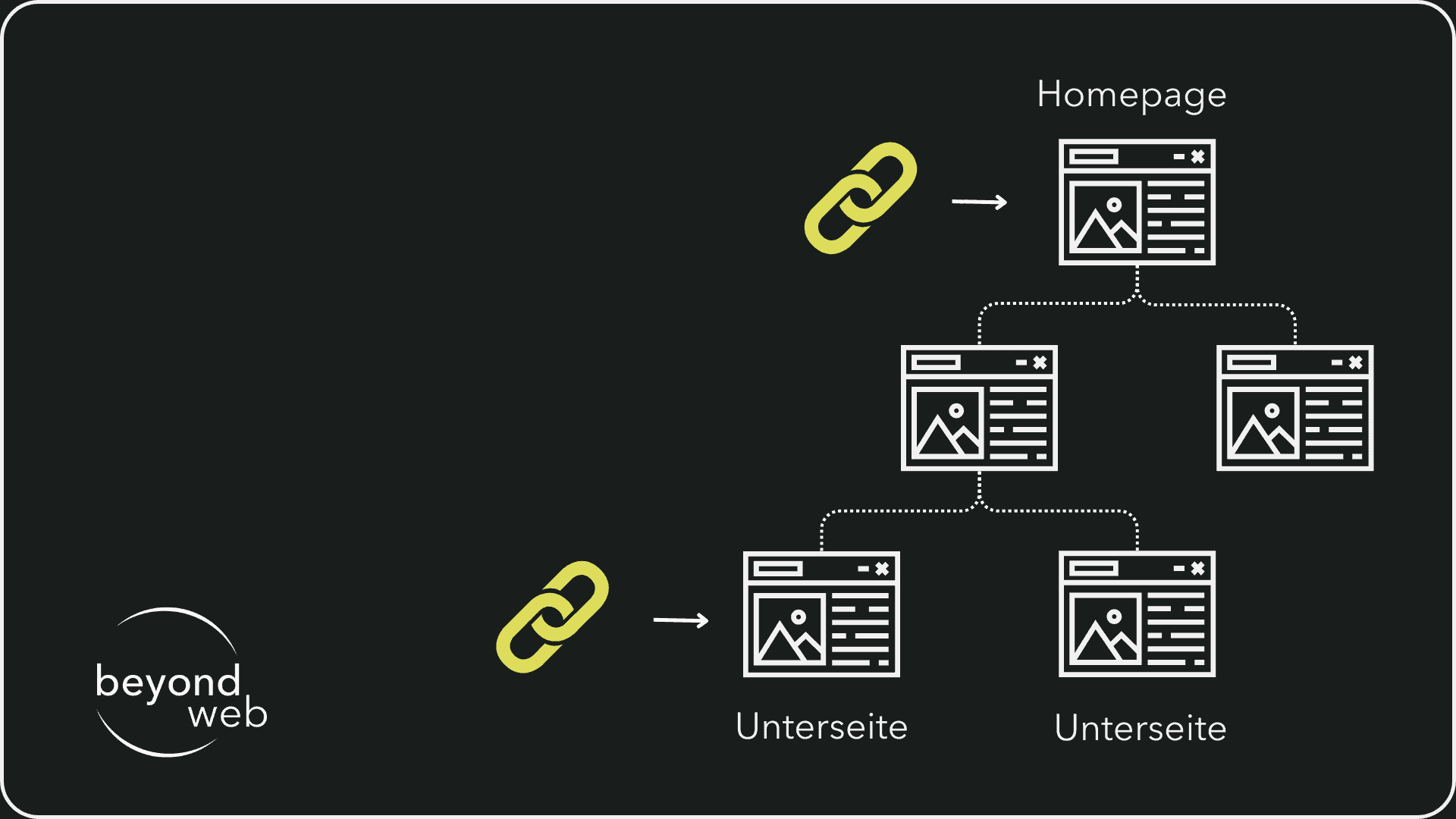
Footer-Links
Backlinks die im Footer einer Website platziert sind, werden von Suchmaschinen oft unterschiedlich bewertet, abhängig von diversen Faktoren.
Während Footer-Links auf jeder Seite der Website erscheinen und somit häufige Sichtbarkeit haben, haben sie aufgrund ihrer allgegenwärtigen Präsenz tendenziell weniger Gewicht aus SEO-Perspektive.
Allerdings können auch Footer-Links, wenn sie thematisch relevant und im Kontext platziert sind, einen guten Wert übermitteln.
Viele Webdesign Agenturen beispielsweise platzieren bei ihren Kunden einen Backlink im Footer (z.B. Designed by Agentur X).
Des Weiteren können hilfreiche Links im Footer generell zu einer besseren Nutzererfahrung beitragen.
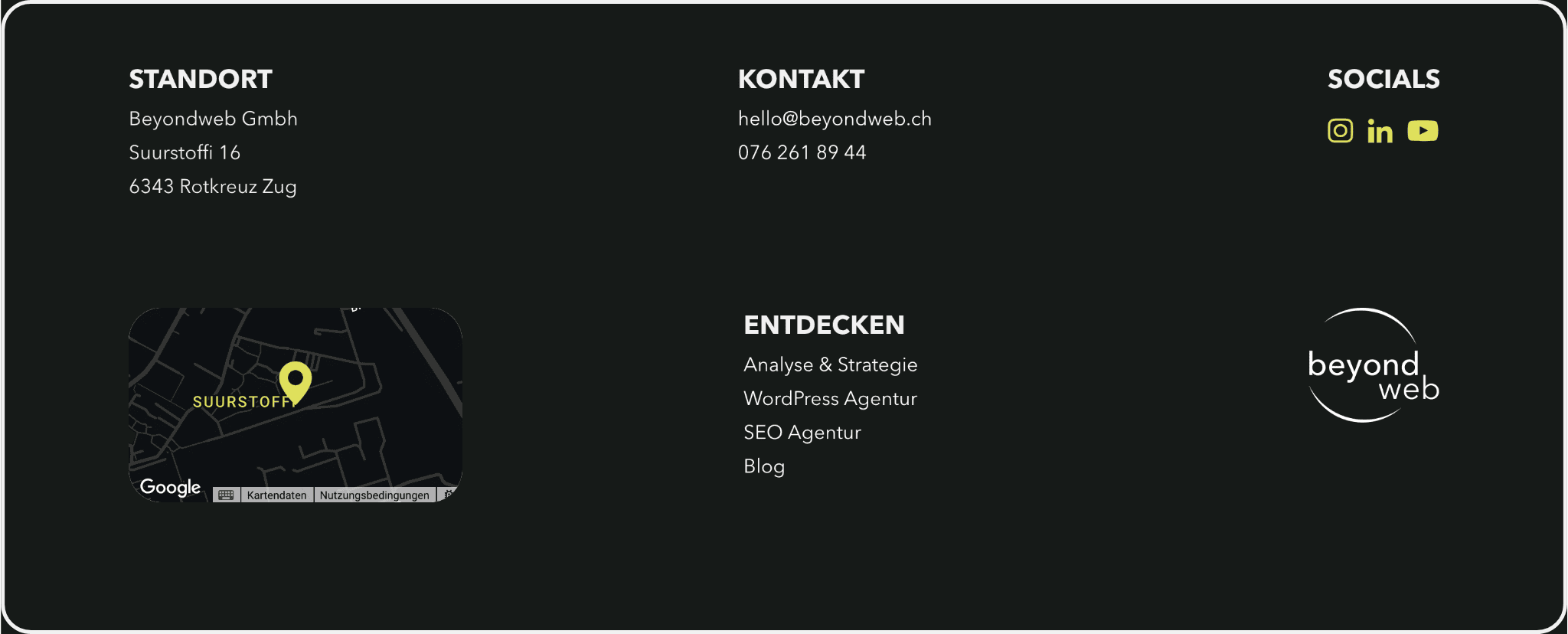
Kontext der Linkplatzierung
Unabhängig von der spezifischen Seite, auf der ein Backlink platziert ist, spielt der Kontext der Linkplatzierung eine entscheidende Rolle.
Ein Link, der mitten im Hauptinhalt einer Seite platziert ist, wird oft als relevanter und natürlicher betrachtet als ein Link, der isoliert oder zusammen mit zahlreichen anderen Links platziert ist
Achte deshalb darauf, dass die Backlinks möglichst im Fliesstext platziert werden, umgeben von thematisch passendem Inhalt.
2. Verhältnis der ausgehenden vs. eingehenden Backlinks
Viele SEO-Experten aber auch Leihen schauen bei der Bewertung eines Backlinks nur auf das Domain Rating (DR), dass Auskunft über die Autorität einer Domain ausgibt.
Das DR bietet zwar einen guten Anhaltspunkt, doch aus meiner Erfahrung ist bei der Bewertung von Backlinks das Verhältnis der ausgehenden zu den eingehenden Backlinks einer Website eine genauso relevante Grösse.
Diese Metrik ist entscheidend, da sie Informationen liefert, wie viel Linksaft eine Website an eine einzelne Domain weitergeben kann.
Stell dir vor, eine renommierte Online-Bibliothek mit einem Domain Rating (DR) von 65, dass sich aus 10’000 eingehende Links zusammensetzt, setzt einen Backlink zu deiner Webseite.
Wenn diese Online-Bibliothek nun bereits zu 200.000 anderen Websites Links vergeben hat, würde der Linkjuice, der an deine Webseite übertragen wird, vereinfacht ausgedrückt, lediglich ein Zweihunderttausendstel der gesamten Linkkraft betragen.
Würde dieselbe Online-Bibliothek mit einem DR von 65 jedoch nur auf deine Seite verlinken (und keine anderen Domains), erhielte dein Link den vollen Linkjuice dieser Website (unter der Annahme, dass es keine internen Links gibt).
3. Autorität der verlinkenden Website
Neben den Faktoren, die ich bereits erwähnt habe, ist die Autorität einer verlinkenden Website natürlich immer noch ein entscheidender Faktor im Rahmen der Backlink-Bewertung.
Die Autorität wirkt sich unmittelbar auf die Bewertung der verlinkten Website ein, indem sie auf eine gewisse Weise eine «Empfehlung» für die verlinkte Seite darstellt.
Die Autorität einer Website kann durch verschiedene Metriken gemessen werden, von denen zwei der bekanntesten das Domain Rating (DR) von Ahrefs und die Domain Authority (DA) von Moz sind.
Diese Metriken bieten eine Einschätzung darüber, wie gut eine Webseite in Suchmaschinen abschneiden könnte, basierend auf der Qualität und Quantität ihrer eingehenden Links.
Das Domain Rating (DR) von Ahrefs beurteilt die Autorität einer Domain basierend auf der Anzahl und Qualität ihrer Rückverweise. Es ist ein numerischer Wert zwischen 0 und 100, wobei höhere Werte auf eine stärkere Autorität beziehungsweise auf eine stärkere Vertrauenswürdigkeit hinweisen.
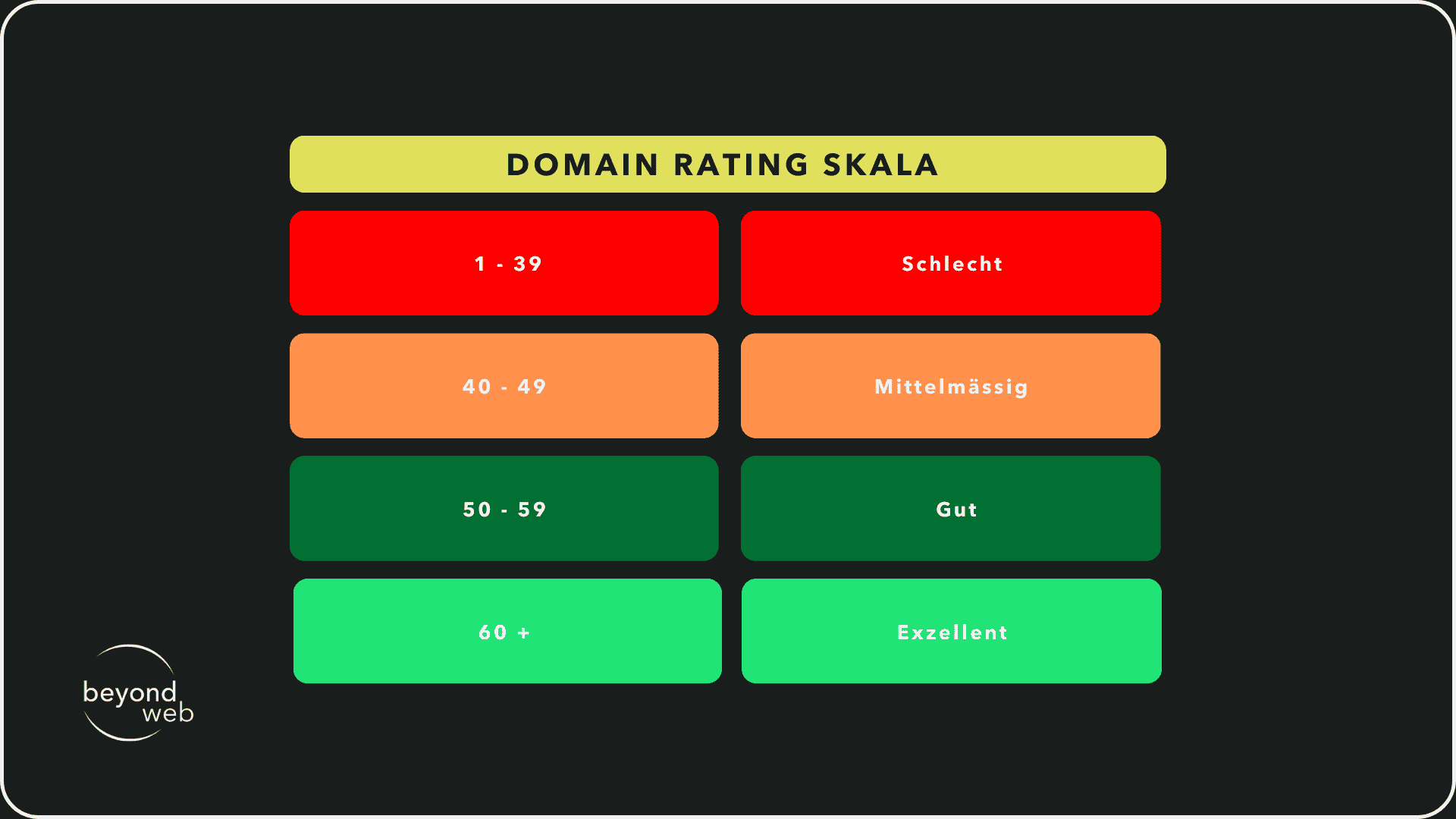
Die Domain Authority (DA) von Moz funktioniert ähnlich, auch sie bewegt sich auf einer Skala von 0 bis 100 und basiert auf verschiedenen Faktoren, darunter Linkzahlen und Linkqualität.
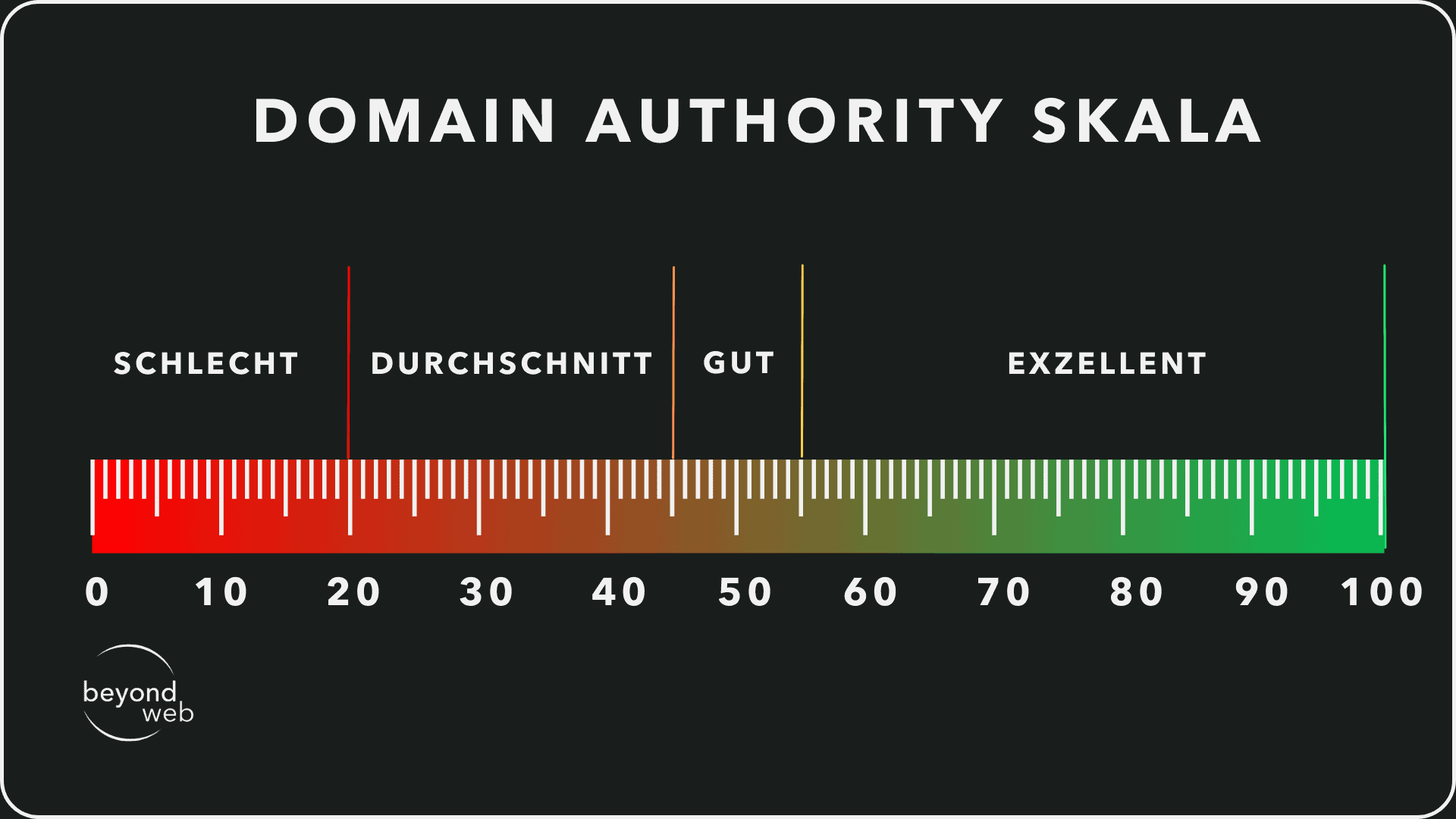
Die Bewertung von Metriken, insbesondere solchen wie dem Domain Rating (DR), muss aber stets im Kontext betrachtet werden. Es ist essenziell zu verstehen, dass solche Bewertungsskalen je nach geografischem Standort, Branche oder anderen spezifischen Faktoren variieren können.
Die Annahme, dass ein bestimmtes Rating, beispielsweise ein DR von 60+, in jedem Kontext als exzellent angesehen wird, wäre zu vereinfachend. Ein DR von 1 bis 39 mag hingegen in manchen Kontexten als suboptimal erscheinen, doch diese Zahlen allein bieten nicht das vollständige Bild.
Zum Beispiel könnte eine Webseite mit einem DR von 40 in einer speziellen Nische oder Branche tatsächlich führend sein, da sie im Vergleich zu ihren direkten Konkurrenten ein höheres Rating hat.
In einem solchen Szenario wäre es unangemessen, den DR von 40 als bloss «mittelmässig» zu betrachten, wenn er in Wahrheit ein Indikator für Marktführerschaft innerhalb dieses spezifischen Segments ist.
Daher ist es von entscheidender Bedeutung, den jeweiligen Kontext in Betracht zu ziehen und die Bewertungsskala entsprechend anzupassen.
Zusätzlich ist es, sowohl beim Domain Rating von Ahrefs, als auch bei der Domain Authority von Moz, deutlich leichter niedrigere Werte zu erhöhen als höhere Werte noch weiter zu erhöhen.
Stell dir vor, du besitzt eine Website mit einem DR von 10.
Diese Website hat leichtere Bedingungen ihren Score um +10 auf ein DR von 20 zu erhöhen, als eine Website die bereits einen DR von 60 besitzt und dies um +10 auf 70 erhöhen möchte.
Für beide Metriken herrschen ausserdem auch einige Limitierungen und Kritikpunkte:
Werden nicht von Suchmaschinen verwendet
Es ist wichtig zu beachten, dass weder DR noch DA von Suchmaschinen wie Google verwendet werden.
Das heisst, sie werden von Suchmaschinen wie beispielsweise Google nicht als Rankingfaktor berücksichtigt, sondern sind lediglich Proxies, wie Google die Autorität einer Website betrachtet.
Unvollständig
Sowohl das Domain Rating als auch die Domain Authority berücksichtigen in meinen Augen nicht alle Faktoren, die für die Autorität einer Seite ausschlaggebend sind.
Diese Metriken geben beispielsweise keinen Aufschluss über den organischen Traffic, das Domain-Alter, die Markenbekanntheit oder die thematische Relevanz einer Domain
Manipulierbar
Es gibt Möglichkeiten, solche Metriken durch den Kauf von Backlinks oder andere Black-Hat-SEO-Taktiken künstlich zu erhöhen.
Beispielsweise kann durch den Kauf von massenhaften Spam-Links das Domain Rating erhöht werden, auch wenn dies de facto negative Einflüsse auf die Autorität einer Domain hat.
Daher sollte man sich meiner Meinung nach nicht ausschliesslich auf das Domain Rating oder die Domain Authority verlassen.
Zusammenfassend sehe ich beide Metriken als nützliche Werkzeuge, die mir Einblicke in die potenzielle Autorität einer Webseite bieten. Es ist jedoch wichtig, diese als Teil eines grösseren Sets von SEO-Metriken zu betrachten und nicht als alleinige Massstäbe für Autorität.
Wie ermitteln Suchmaschinen Autorität?
Das Konzept der Autorität entspringt aus verschiedenen Algorithmen von Suchmaschinen, von denen Googles PageRank der bekannteste ist.
Der PageRank, Ende der 1990er Jahre entwickelt, ist das bekannteste Verfahren zur Gewichtung und Bewertung von Websites.
Er analysiert, wie vertrauenswürdig und glaubwürdig eine Website im weltweiten Netz ist, indem er Faktoren wie die Qualität und Quantität der eingehenden Links, den produzierten Inhalt und die Struktur der Website selbst berücksichtigt.
Wie funktioniert der PageRank-Algorithmus?
Das Ziel des Algorithmus ist es herauszufinden, auf welchen Websites sich ein Nutzer, der über eine sehr lange Zeit zufällig auf die Links klickt, am wahrscheinlichsten aufhält.
Der PageRank-Algorithmus funktioniert dabei durch eine Abfolge von Schritten:
- Er erstellt eine Matrix, die die Verlinkungen der Websites untereinander beschreibt
- Anschliessend wird ein Vektor definiert, der so viele Einträge hat wie die Matrix Spalten
- Dieser Vektor wird anschliessend mit der Matrix multipliziert
- Schritt 3 wird mit dem resultierenden Vektor wiederholt, bis keine Änderungen mehr im Ergebnisvektor auftreten.
Ist es schon eine Weile her, seitdem du dich in der Schule mit Vektorgeometrie auseinandergesetzt hast?
Kein Problem, hier wird das Konzept auf möglichst zugänglich Art und Weise anhand von Florian Dalwigks Youtube-Video veranschaulicht:
Stell dir vor, dass wir uns in einem «Mikrointernet» befinden, dass nur aus den vier Websites Facebook, YouTube, Amazon und Netflix besteht.
Die vier Websites verlinken sich gegenseitig folgendermassen:
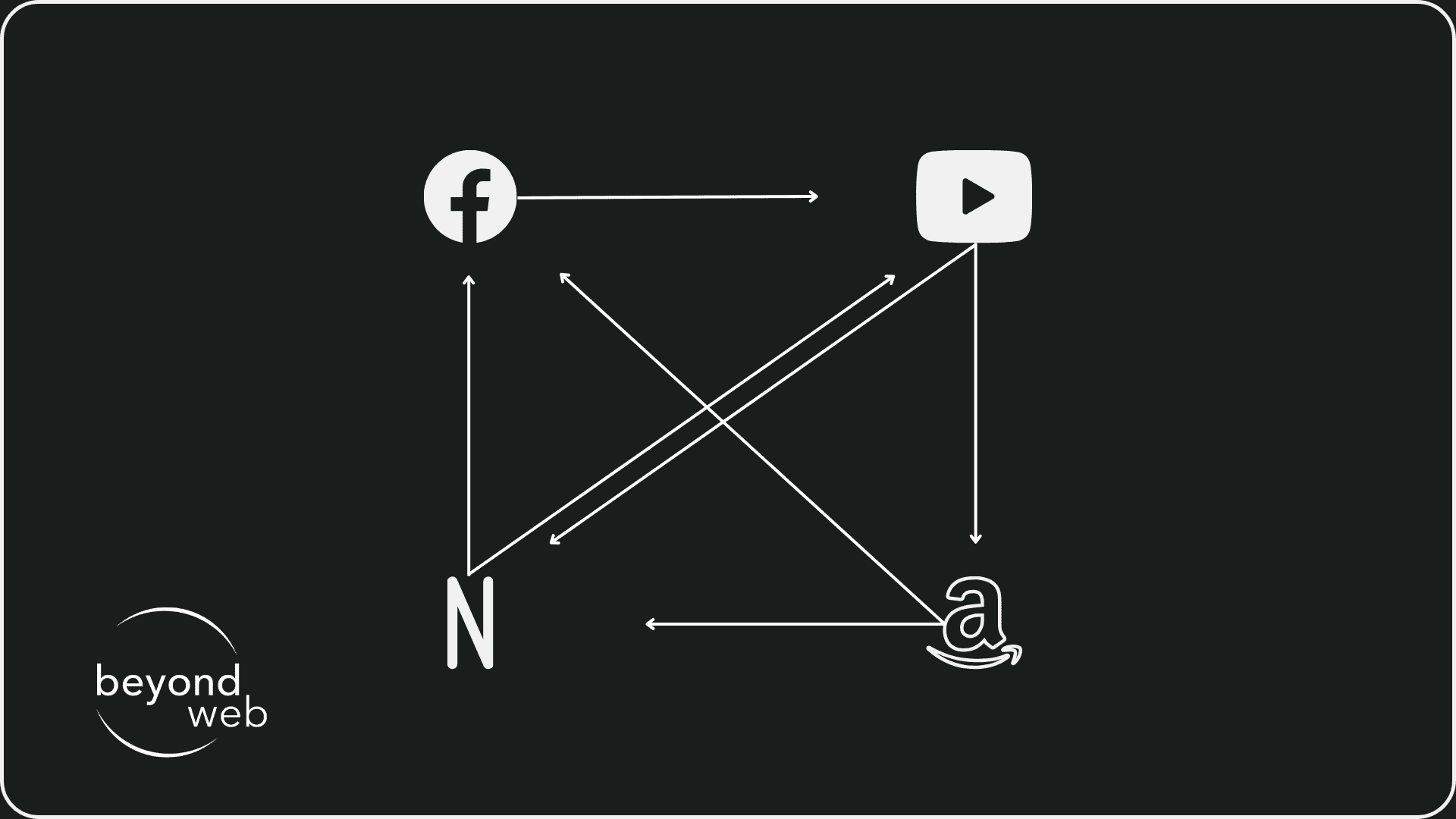
Die Tabelle zeigt noch einmal genauer, welche der vier Websites welche eingehenden beziehungsweise ausgehenden Links besitzt:
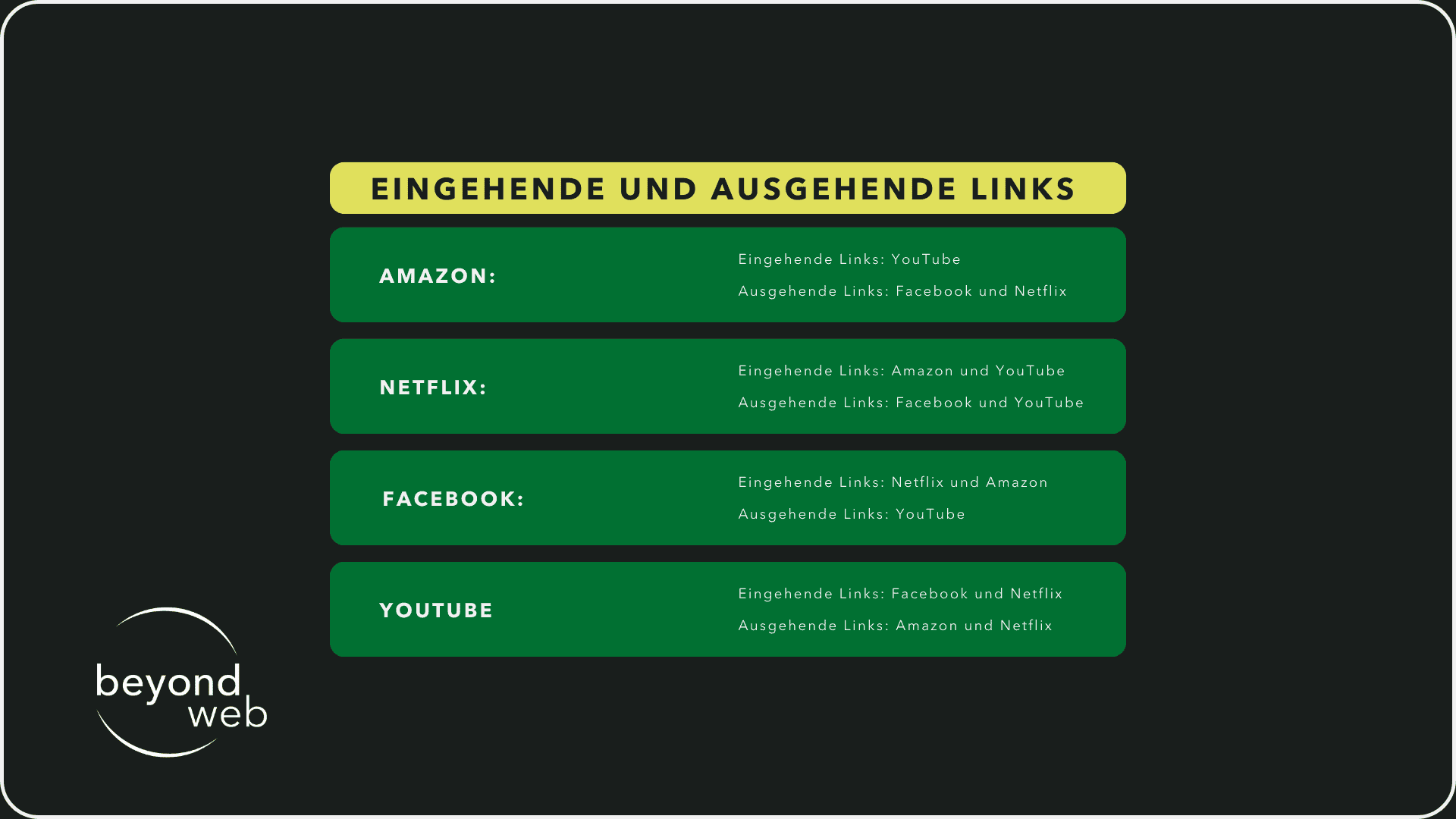
Wenn man davon ausgeht, dass jede dieser Websites durch einen Link auf eine andere einen vollen Punkt – also 100% (1,0) – geben kann, und dieser Punkt sich aufteilt, wenn eine Website auf mehr als eine andere verlinkt, kann man die oben dargestellte Verlinkungsstruktur in eine Matrix übertragen
So wird beispielsweise, wenn Amazon auf Facebook und Netflix verweist, beiden Websites jeweils ein halber Punkt (0,5) zugeordnet
Die daraus resultierende Matrix sieht folgendermassen aus:
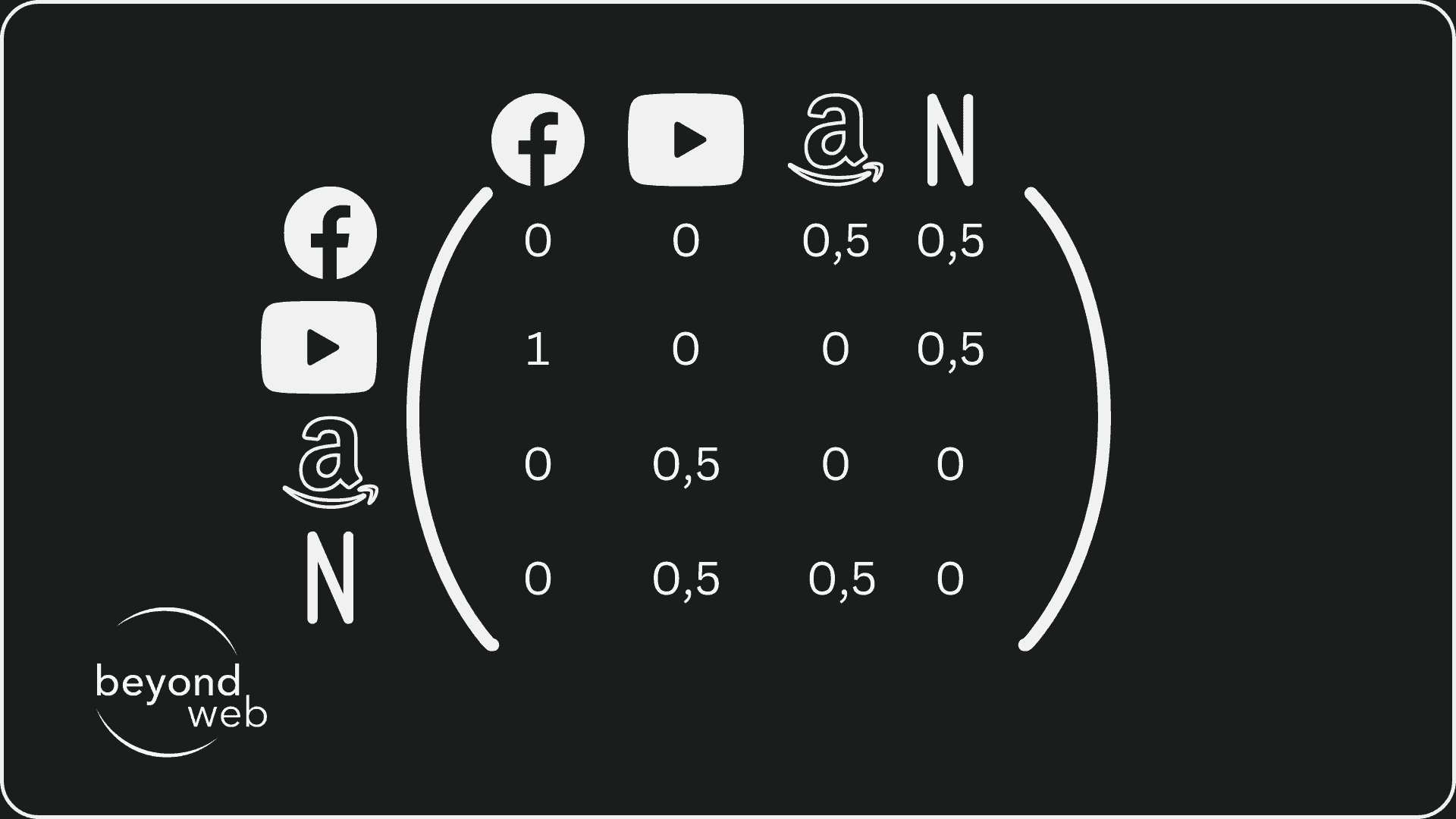
Da das Internet in diesem Beispiel nur aus 4 Websites besteht, können wir ohne weiteres Wissen die Annahme treffen, dass jede Website eine 25 % (0,25) Wahrscheinlichkeit hat, dass sie besucht wird.
Wenn nun die 25 % Wahrscheinlichkeit eines Besuches mit unserer oben dargestellten Matrix der Verlinkungen multipliziert wird, ergibt sich ein neuer Ergebnisvektor für die 4 Websites.
Durch mehrfache Multiplikationen des jeweiligen Ergebnisvektors kann berechnet werden, welche der, in unserem Fall, vier Seiten am längsten besucht wird.
Dabei werden so lange Multiplikationen durchgeführt, bis sich die Werte im Ergebnisvektor stabilisieren, das heisst, sie verändern sich nicht mehr.
Nach dieser Logik des Page Ranks Algorithmus ergibt sich in unserem Beispiel bei YouTube die höchste Wahrscheinlichkeit eines Besuchs, gefolgt von Netflix, Facebook und Amazon.
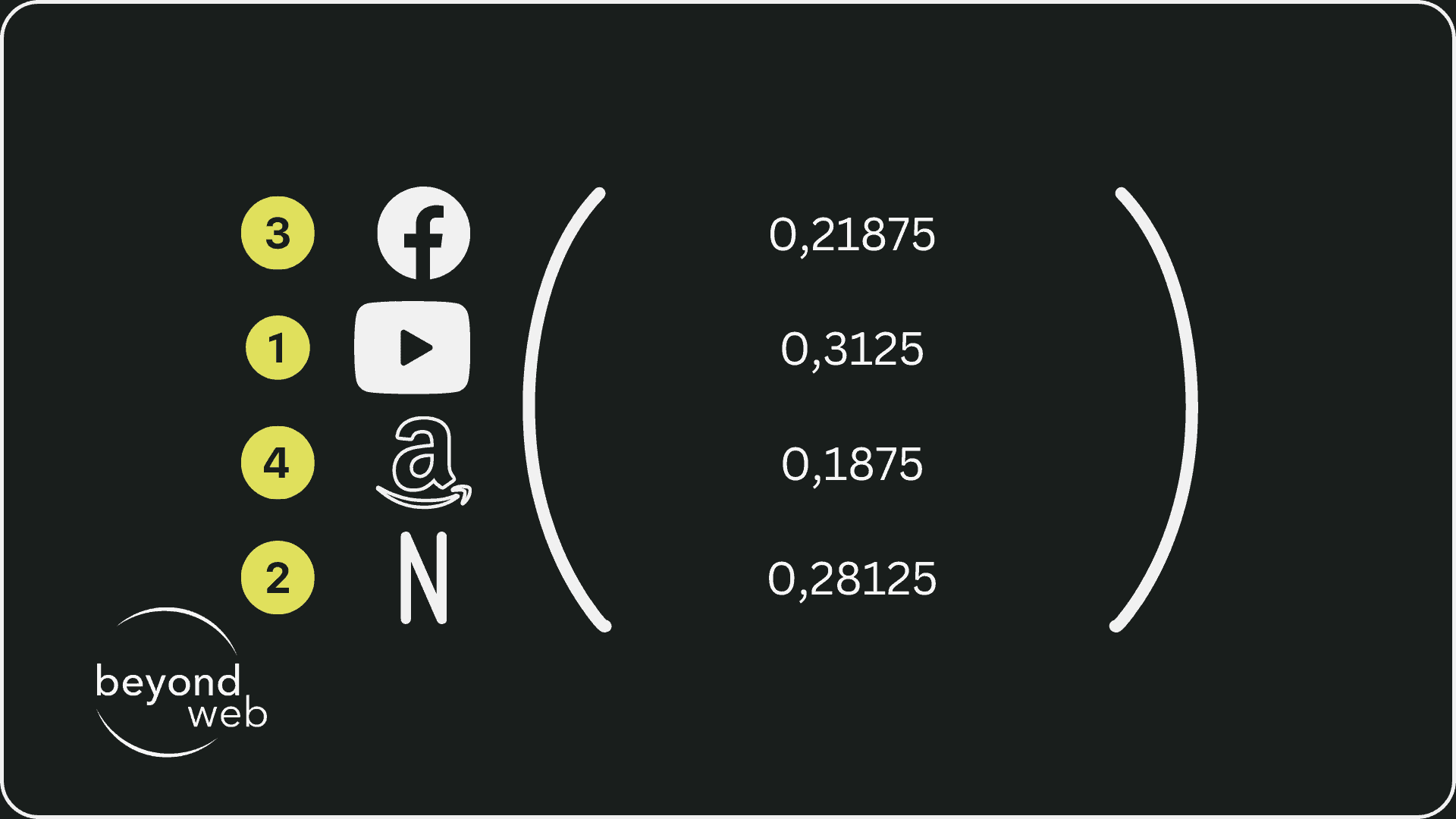
Ein besonderes Augenmerk verdient in diesem Beispiel der Fakt, dass Netflix höher als Facebook gerankt wird, obwohl beide von zwei Links aus verlinkt werden.
Der entscheidende Faktor ist hier, dass ein hoch bewerteter Link vom #1 gerankten YouTube auf Netflix verweist, was dem PageRank von Netflix einen erheblichen Schub gibt.
Dieses Beispiel kann auch auf das reale Internet bezogen werden und zeigt den immensen Einfluss, den grosse, autoritative Websites wie YouTube auf das Ranking anderer Websites haben
Hierin liegt der Grund, warum Websites, die von solch grossen Seiten verlinkt werden, in den Google-Suchergebnissen häufig ganz oben stehen.
Am Ende des Tages wird dieser Algorithmus, wenn auch in einer viel komplexeren Form, auf das gesamte Internet angewendet.
4. Thematische Relevanz des Backlinks
Die thematische Relevanz eines Backlinks spielt eine unerlässliche Rolle in der Qualität und Effektivität einer Verlinkungsstrategie
Hierbei geht es darum, wie eng die inhaltlichen Überschneidungen zwischen der verlinkenden und der verlinkten Seite sind.
Im Idealfall sollte der verlinkende Content in einem klaren inhaltlichen Zusammenhang mit dem Content der verlinkten Website stehen.
Ein thematisch relevanter Backlink sendet ein starkes Signal an die Suchmaschine, dass die jeweilige Webseite eine Autorität in einem speziellen Fachgebiet darstellt
Dies stärkt nicht nur die Glaubwürdigkeit der eigenen Webseite aus Sicht von Google & Co., sondern fördert auch eine positive User Experience, indem Nutzer durch den Link zu weiterführenden, relevanten Informationen geführt werden
Darüber hinaus kann dir die thematische Relevanz von Backlinks dabei helfen, eine Webseite in einer bestimmten Nische oder Branche zu positionieren
Wenn du beispielsweise im Bereich «Webdesign» tätig bist und regelmässig Backlinks von renommierten Websites aus der Webdesign-Branche erhältst, kann dies die Wahrscheinlichkeit erhöhen, dass deine Seite bei suchmaschinenrelevanten Anfragen aus diesem Bereich besser positioniert wird
Es ist allerdings auch entscheidend zu verstehen, dass das Generieren thematisch relevanter Backlinks authentisch und natürlich erfolgen sollte
Manipulative Techniken, um Links zu generieren, können von Suchmaschinen erkannt und geahndet werden
Daher sollte die Erstellung hochwertigen Contents, der natürlich verlinkt werden möchte, stets im Mittelpunkt jeder SEO- und Backlink-Strategie stehen.
Um den Aufbau thematisch relevanter Backlinks zu unterstützen, kann beispielsweise eine Content-Strategie entwickelt werden, die nicht nur den eigenen Content im Blick hat, sondern auch die Schaffung von Inhalten, die für Seitenbetreiber aus der eigenen Branche oder Nische linkenswert sind.
Dies können beispielsweise Studien, Infografiken oder andere Inhalte sein, die einen hohen Mehrwert bieten und für andere Seitenbetreiber interessant genug sind, um sie ihren eigenen Nutzern zur Verfügung zu stellen.
Auf diese Weise entstehen Backlinks, die sowohl für die Suchmaschinenoptimierung als auch für die Nutzererfahrung einen echten Mehrwert darstellen
5. Vertrauenswürdigkeit der verlinkenden Domain (Spam Score)
Die Vertrauenswürdigkeit einer verlinkenden Domain, oft reflektiert durch den Spam Score, ist ebenfalls ein entscheidendes Element, um die Qualität und Zuverlässigkeit von Backlinks zu bewerten.
Ein höherer Spam Score weist typischerweise auf potenzielle Risiken oder eine Historie von Spam-Praktiken der jeweiligen Domain hin.
Dies kann wiederum negative Auswirkungen auf die Suchmaschinenoptimierung (SEO) und das Online-Reputationsmanagement der mit ihr verlinkten Webseite haben.
Der Spam Score wird dargestellt auf einer Skala von 0 bis 17, wobei 0 als das geringste und 17 als das höchste Risiko interpretiert wird.
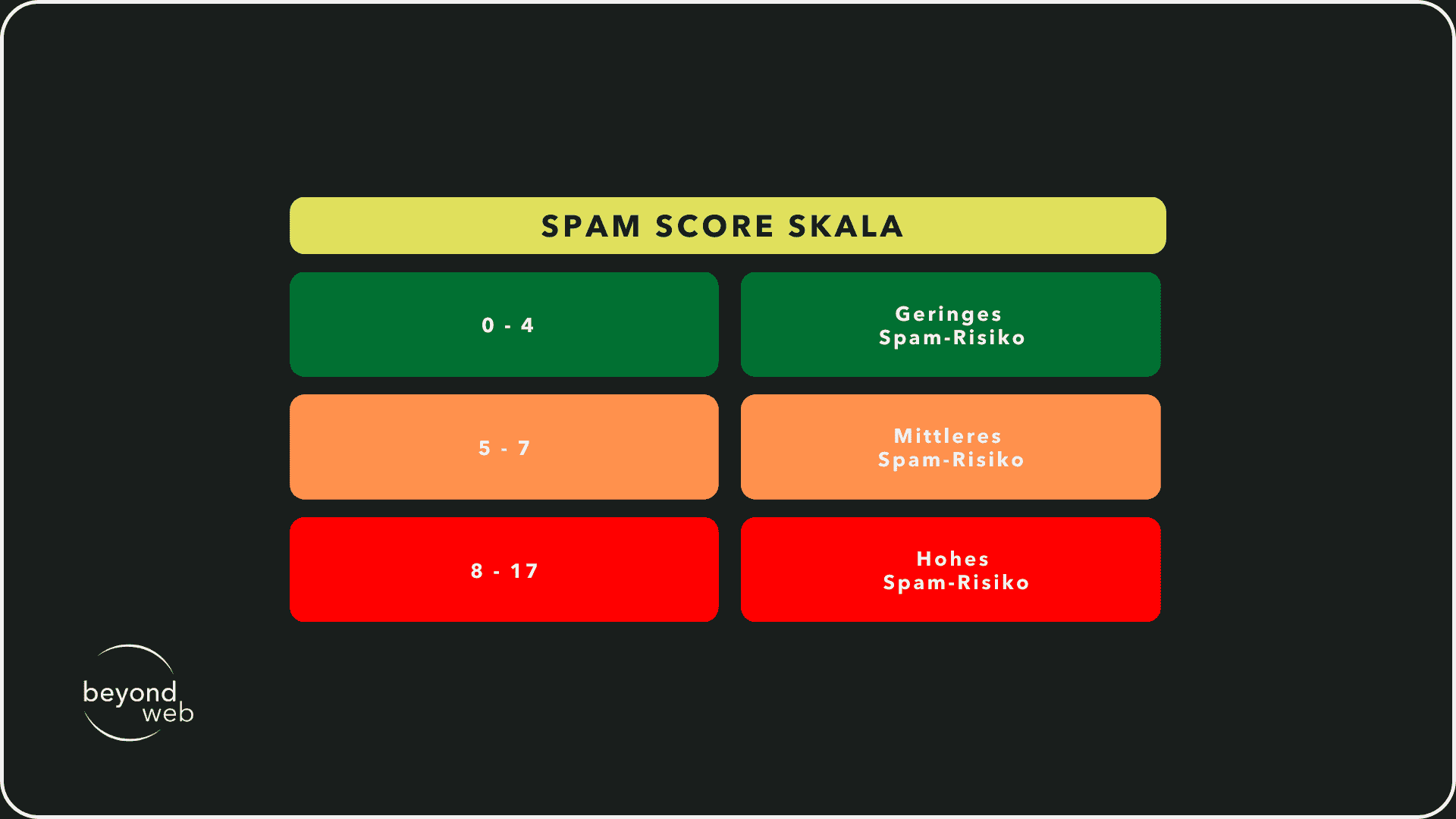
Domains mit einem hohen Spam Score können schädlich für deine Google-Rankings sein, wenn diese auf deine Website verlinken, da diese Seiten als weniger vertrauenswürdig eingestuft werden.
Um den Spam Score einer Website zu überprüfen, können verschiedene Online-Tools eingesetzt werden, wie z.B. der Spam Score Domain Checker.
Dieses Werkzeug analysiert die Vertrauenswürdigkeit und Sicherheit einer Domain, indem es verschiedene SEO- und Webpräsenz-Parameter evaluiert.

Neben dem Überprüfen der Vertrauenswürdigkeit kann das Tool auch dazu beitragen, mögliche Sicherheitsprobleme oder Manipulationsversuche, wie den Einsatz von Black-Hat-SEO-Techniken, zu identifizieren.
Black-Hat-SEO-Techniken sind SEO-Techniken, die versuchen den Google Algorithmus mit illegalen Mitteln zu manipulieren.
Mehr Informationen zu erlaubten und unerlaubten SEO-Techniken finden sie bei den Google Search Essential Guidelines.
Nicht nur aus der Perspektive der Suchmaschinenoptimierung ist es klug, den Spam Score im Auge zu behalten, sondern auch unter dem Aspekt des Online-Reputationsmanagements.
Ein sicherer und vertrauenswürdiger Linkaufbau sollte immer auf sauberen und ehrlichen Methoden beruhen, um sowohl kurz- als auch langfristig erfolgreiche Ergebnisse zu erzielen.
Daher ist es essenziell, bei der Überprüfung von Backlinks nicht nur deren Anzahl und Relevanz zu betrachten, sondern auch die Seriosität und Vertrauenswürdigkeit der verlinkenden Seiten zu berücksichtigen.
So stellst du sicher, dass dein Backlink-Profil nicht nur stark, sondern auch sauber und nachhaltig ist.
6. Handelt es sich um einen DoFollow Backlink?
Ein DoFollow Backlink, der auf deine Webseite verweist und Interaktionen oder Kommentare auf deiner Webseite ermöglicht, trägt erheblich zur Verbesserung der Suchmaschinenoptimierung (SEO) bei.
Dieser Linktyp signalisiert Suchmaschinen, dass der verlinkende Webmaster die Seite unterstützt und dass die Suchmaschinen diesen Link bei der Berechnung des PageRanks berücksichtigen sollten.
Im Gegensatz dazu sagen NoFollow Links der Suchmaschine, dass sie einen Link nicht verfolgen und bei der Berechnung des Rangs nicht berücksichtigen sollten.
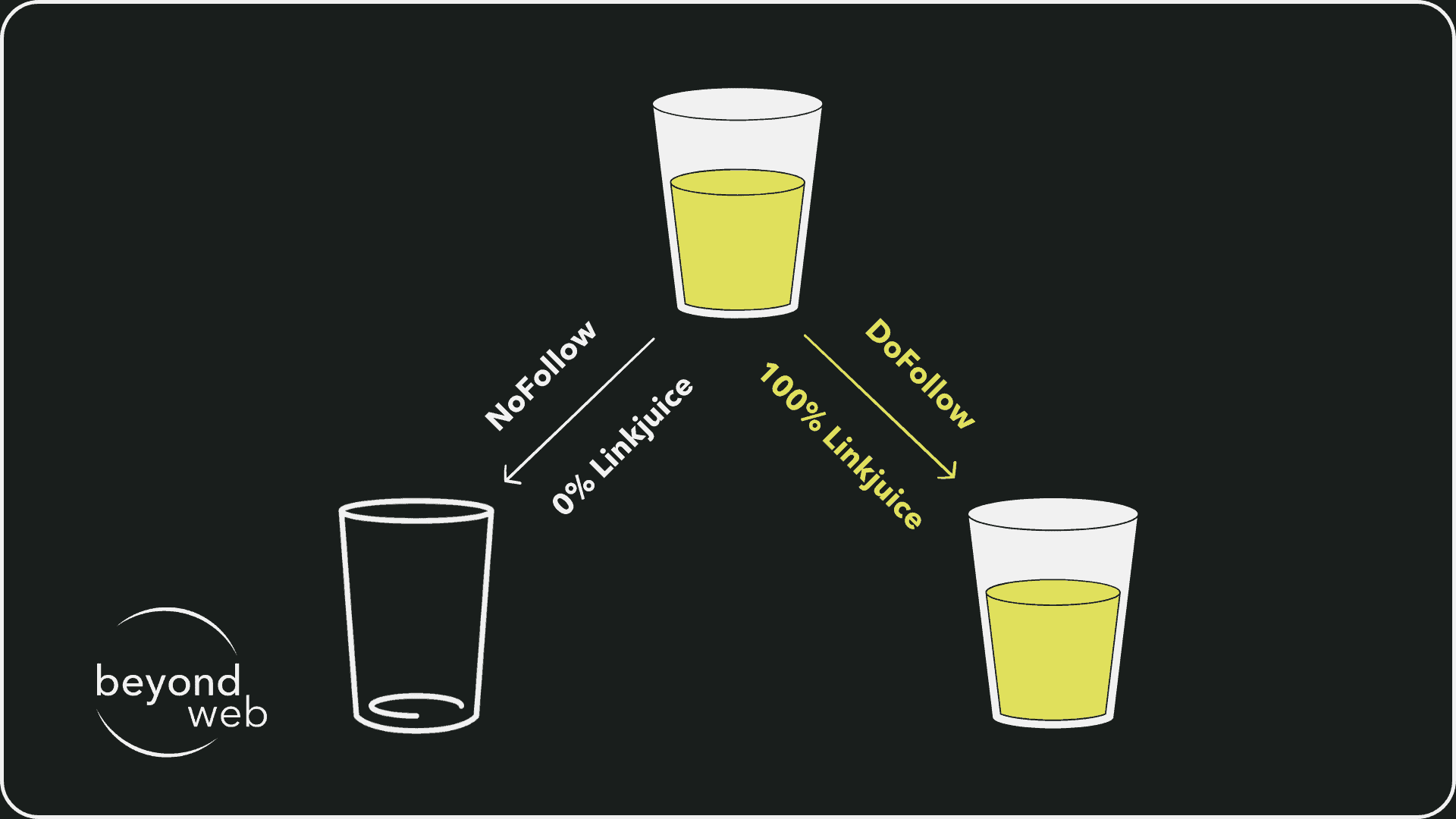
Es ist essentiell, eine ausgewogene Mischung aus DoFollow- und NoFollow-Links zu pflegen, um ein natürlich wirkendes Backlink-Profil aufzubauen.
Zu viele DoFollow-Links können als Manipulationsversuch der Seite angesehen werden und möglicherweise zu einer Abstrafung durch die Suchmaschine führen.
Um die Natur eines Backlinks, ob DoFollow oder NoFollow, zu überprüfen und eine umfassende Analyse deines Backlink-Profils durchzuführen, empfehle ich professionelle SEO-Tools zu verwenden.
Eines der führenden Tools in diesem Bereich stammt von Ahrefs.
Mit Ahrefs Backlink Checker kannst du das Backlinkprofil deiner Domain sowie deiner Konkurrenten kostenlos überprüfen und dadurch wertvolle Insights ableiten.
Das Tool ermöglicht es dir, die Stärke und Autorität deines Backlink-Profils zu beurteilen und dies mit der Konkurrenz abzugleichen. Zudem kannst du die Backlinks der Konkurrenz identifizieren, die für dich möglicherweise ebenfalls relevant sein könnten.
Das Weiteren bietet Ahrefs auch Informationen über die verwendeten Ankertexte, die Gesamtzahl der Backlinks, die Domain Rating (DR) und die URL Rating (UR).
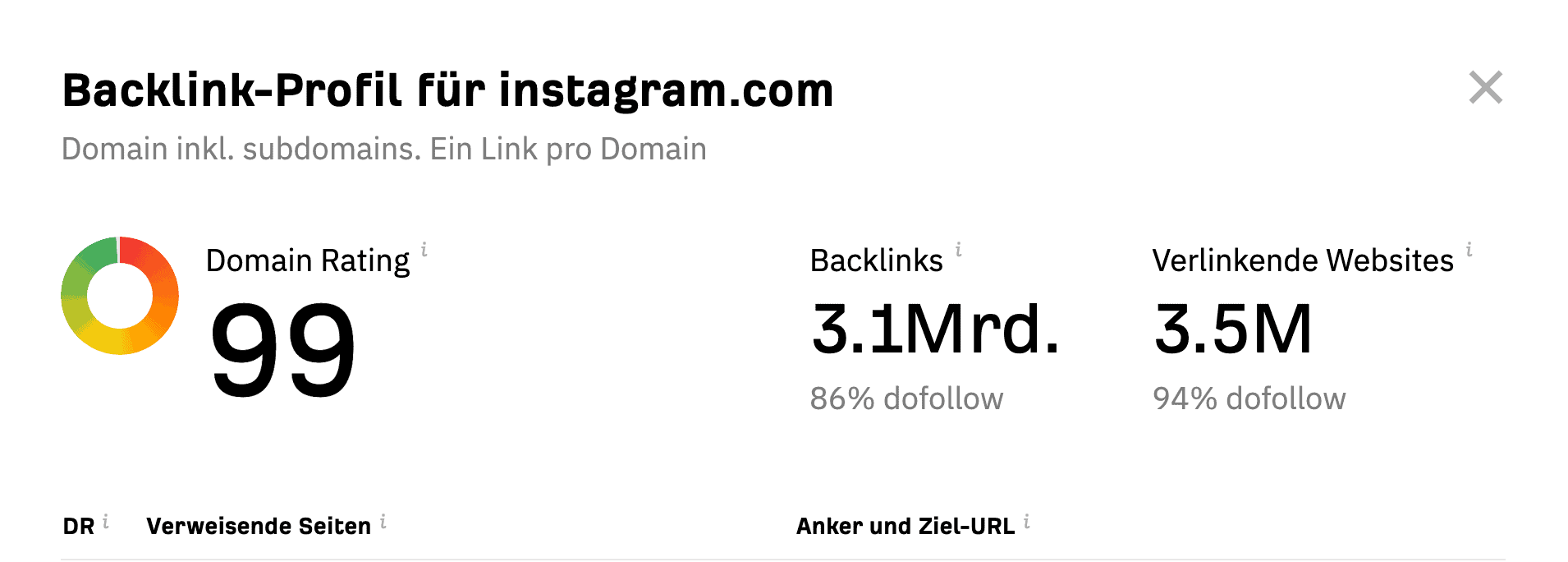
7. Welcher Ankertext wurde gewählt?
Meiner Meinung nach kann die Bedeutung des Ankertexts nicht hoch genug eingeschätzt werden.
Der Ankertext, auch Linktext genannt, ist das sichtbare, klickbare Wort.
Dieses kleine Detail ist von grosser Bedeutung, da der Ankertext sowohl dem Leser als auch den Suchmaschinen wichtige Informationen über den Inhalt der verlinkten Seite bietet.
Ein sorgfältig ausgewählter Ankertext sollte in der Lage sein, sowohl für die User deiner Website als auch für die Suchmaschine Relevanz und Mehrwert zu bieten.
Wenn ein Ankertext ausgewählt wird, sollte er also dementsprechend eine thematische Relevanz zur verlinkten Seite aufweisen.
Das heisst: wenn zum Beispiel ein Webdesign-Blog einen Fachbegriff als Ankertext benutzt, um zu einer Erklärungsseite zu linken, dann passt das thematisch gut zusammen.
Die Auswahl eines passenden Ankertexts ist deshalb nicht nur förderlich für die Steigerung der Click-Through-Rate (CTR), indem sie beim Leser Interesse oder Neugier weckt, sondern auch für die Verbesserung des Rankings in den Suchmaschinen.
Denn Suchmaschinen werten Ankertexte als einen Faktor, um den Inhalt einer Webseite zu begreifen und zu kategorisieren.
Ein relevanter und treffender Ankertext hilft demnach dabei, die Glaubwürdigkeit und Relevanz einer verlinkten Seite zu betonen.
Arten von Ankertexten
Es gibt viele verschiedene Arten von Ankertexten.
Dabei ist es ratsam, unterschiedliche Arten zu verwenden.
Nur durch das Verwenden verschiedene Arten kann eine Überoptimierung verhindert werden, was den Richtlinien der Suchmaschinen entspricht.
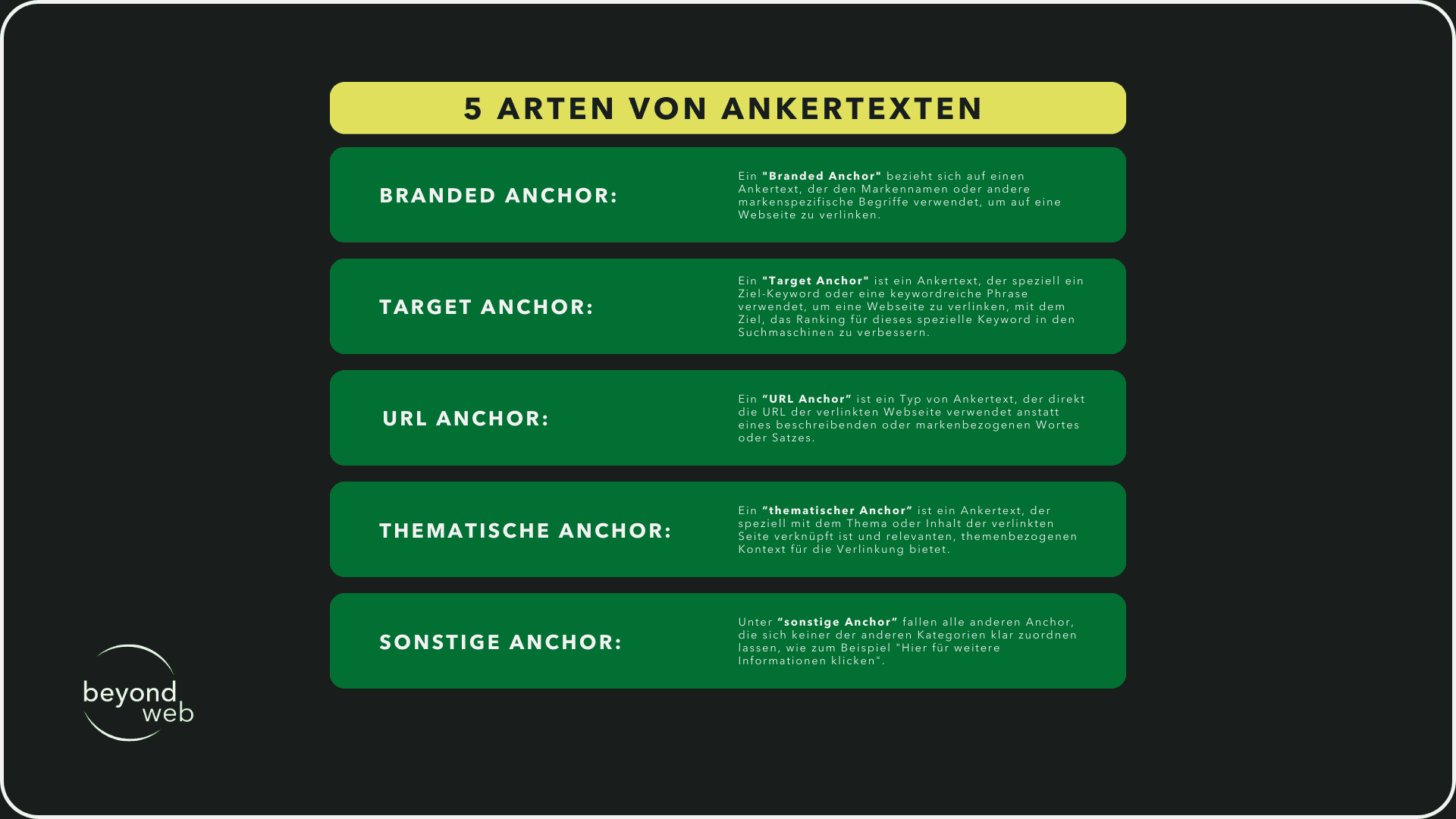
8. Keyword Rankings der verlinkenden Website
Keywords sind ein Indikator für die Sichtbarkeit, Autorität und sogar die Glaubwürdigkeit einer Website in einem bestimmten Themenbereich.
Das Ranking für bestimmte Keywords, besonders für solche mit hoher Suchanfrage und Relevanz in Branchen, kann die Menge und Qualität des Traffics beeinflussen, den eine Website erhält.
Zur Bewertung eines Backlinks sollten aus meiner Sicht jedoch nicht nur die Keywords herangezogen werden, sondern auch gezielte Sichtbarkeitsmetriken.
Besonders hervorzuheben sind hierbei der Sichtbarkeitsindex von Sistrix (SI) und der Online Value Index von XOVI (OVI).
Beide Metriken reflektieren die «geschätzte Sichtbarkeit» einer Domain.
Backlinks von Websites mit ausgeprägten Sichtbarkeitsmetriken, insbesondere hohen SI- oder OVI-Werten, beeinflussen das Google-Ranking signifikant stärker
Deshalb ist es klug, sowohl auf Keywords als auch auf massgebliche Sichtbarkeitsmetriken zu achten, wenn man die Wertigkeit und Bedeutung eines Backlinks einschätzt.
Keyword-Rankings in Zusammenhang mit Backlinks
Die Keyword-Rankings der verlinkenden Website haben einen mehrdimensionalen Einfluss auf den Wert, den ein Backlink einer Webseite zufügt.
Erstens, eine Website, die für relevante und konkurrenzfähige Keywords in Suchmaschinen hoch rangiert, wird automatisch als autoritäre und fachkundige Quelle angesehen.
Ein Backlink von einer solchen Quelle kann als stärker und wertvoller angesehen werden, weil er eine Art Empfehlung impliziert.
Wenn beispielsweise eine Website, die für wichtige Keywords rund um «Webdesign» hoch rangiert, auf eine andere Webdesign Website verlinkt, interpretieren Suchmaschinen diesen Link als einen Vertrauensbeweis.
Die Annahme hier ist, dass eine Website mit guten Rankings bei relevanten Keywords sorgfältig auswählt, auf wen sie verlinkt, um die eigene Glaubwürdigkeit und den Nutzerwert zu bewahren.
Zweitens gibt es den Traffic-Aspekt.
Websites, die für beliebte Keywords rangieren, ziehen in der Regel ein signifikantes Volumen an organischem Traffic an.
Organischer Traffic bezieht sich dabei auf die Zahl der Besucher, die über bestimmte Suchergebnisse kommen.
Ein Backlink von einer solchen Website, die für beliebte Keywords hoch rangiert, bringt auf der einen Seite also Vorteile durch erhöhte Übertragung von Linkjuice, auf der anderen Seite aber auch weil ein solcher Backlink die Chance besitzt einen höheren Traffic zu übertragen.
User, die auf der verlinkenden Website nach relevanten Informationen suchen, können demnach durch den Backlink navigieren und so als Referral-Traffic auf der verlinkten Website landen.
Referral Traffic bezieht sich dabei auf die Besuche auf der eigenen Website, die über Links auf einer anderen Website stehen.
Trotzdem sind nicht alle Backlinks von Websites mit hohen Keyword-Rankings per se wertvoll.
Faktoren wie thematische Relevanz, Linkplatzierung und Link-Kontext müssen gleichermassen gewichtet werden, um den tatsächlichen Wert eines Backlinks zu bewerten.
9. Tools zur Analyse von Backlinks
Um die zuvor genannten Faktoren analysieren zu können, empfehle ich die Verwendung verschiedener SEO-Tools.
Meine Favoriten werde ich in den nachfolgenden Abschnitten genauer vorstellen:
Ahrefs
Wie bereits kurz erwähnt hat sich Ahrefs als unverzichtbares SEO-Tool etabliert, das uns SEO-Spezialisten bei der Optimierung der Online-Präsenz unterstützt.
Ahrefs besitzt nach eigenen Angaben die grösste Backlink-Datenbank (neben Google) und ermöglicht dadurch eine detaillierte Analyse des Backlink-Profils einer Website, was essentiell für die Entwicklung effektiver Linkbuilding-Strategien ist.
Das Tool erleichtert zudem die Keyword-Recherche, indem es relevante Keywords identifiziert und wertvolle Metriken wie das Suchvolumen bereitstellt.
Diese Einblicke sind unerlässlich für die Ausarbeitung gezielter Content- und SEO-Strategien, die sowohl für Nutzer als auch Suchmaschinen relevant sind.
Ahrefs bietet ausserdem die Möglichkeit, die Rangpositionen von Websites für bestimmte Keywords zu verfolgen und dabei die SEO-Leistung ständig im Blick zu behalten.
So kann ich beispielsweise schnell auf Veränderungen in den Suchergebnisplatzierungen reagieren.
Ein weiterer Pluspunkt ist die Fähigkeit von Ahrefs, durch die sogenannte Wettbewerbsanalyse die SEO-Taktiken von Konkurrenten zu entschlüsseln.
Dieses Wissen ermöglicht es, die eigenen Strategien zu verfeinern und eine stärkere Position im digitalen Raum zu erlangen.
Einen weiteren Vorteil bietet das Site-Audit-Tool von Ahrefs.
Es ermöglicht umfassende Website-Analysen und hilft dabei sowohl technische als auch On-Page SEO-Probleme zu identifizieren und zu beheben.
Kurz gesagt ist Ahrefs mit seiner breiten Palette an Funktionen ein Schatz für jeden, der sich im digitalen Marketing und insbesondere im Bereich SEO bewegt.
Similarweb
Similarweb ermöglicht, dank seiner umfangreichen Datenbank und vielseitigen Analyse-Tools, tiefgreifende Einblicke in Web-Traffic und Benutzerverhalten zu erlangen
Der Fokus liegt bei Similarweb im Vergleich zu Ahrefs noch stärker auf der Wettbewerbsanalyse von konkurrierenden Websites.
Das Tool ermöglicht es den Nutzern, Traffic-Quellen, Zielgruppenverhalten und Engagement-Metriken von Konkurrenten zu erkunden.
Diese Informationen sind von unschätzbarem Wert, um Markttrends zu identifizieren, eigene Strategien anzupassen und potenzielle Geschäftschancen zu entdecken.
Ein weiteres nützliches und zusätzliches Feature von Similarweb ist die Möglichkeit, den Traffic von Websites in verschiedene Kanäle zu unterteilen.
So kann man genau nachvollziehen, ob die Besucher hauptsächlich über bezahlte Werbeanzeigen, organische Suche, soziale Medien oder andere Quellen auf die Website gelangen.
Diese Einsichten ermöglichen es, die eigene Marketingstrategien zu verfeinern und Investitionen in die Kanäle zu lenken, die den grössten Traffic generieren.
Zudem unterstützt Similarweb beim Identifizieren neuer, relevanter Keywords und beim Auffinden von beispielsweise Influencern, die in der eigenen Branche einen Impact haben.
Diese Erkenntnisse können dann wiederum dazu genutzt werden, Marketing-Kampagnen effektiver zu gestalten und die Online-Präsenz zu stärken.
Keyword Rankings
Hierbei soll das Tool helfen den Rang bestimmter Keywords in den Suchergebnisseiten (SERPs) von Suchmaschinen wie Google zu verfolgen und zu analysieren
Ahrefs bietet diese Funktion zwar auch, jedoch updated Keywordrankings ihre Datenbanken schneller und man erhält akkuratere Einblicke in die aktuellen Rankings der eigenen Website und der Konkurrenz.
Ein zusätzlicher, zentraler Aspekt von Keywordrankings ist die Fähigkeit, die Entwicklung der Keyword-Positionen über Zeiträume hinweg zu verfolgen.
Das Tool bietet in der Regel visuelle Darstellungen der SERP-Platzierungen, wodurch Trends, Verbesserungen oder Verschlechterungen auf einen Blick erkennbar sind
Dies ermöglicht es zeitnah auf Veränderungen im Suchmaschinenranking zu reagieren und Strategien entsprechend anzupassen.
Ein weiteres Feature von Keywordrankings-Tools ist die Fähigkeit, die Performance von Keywords in Bezug auf verschiedene geografische Standorte und Gerätetypen zu analysieren.
Diese regionalen und gerätespezifischen Einblicke sind besonders wertvoll für Unternehmen, die sich auf lokale Märkte konzentrieren oder ihre Website für mobile Geräte optimieren möchten.
Darüber hinaus bieten Keywordrankings-Tools oft auch Einblicke in die Keyword-Strategien von Wettbewerbern.
Durch das Verständnis, für welche Keywords deine Konkurrenten ranken, kannst du deine eigene Strategie entsprechend anpassen und eventuell neue, profitable Keywords identifizieren, die bisher übersehen wurden.
SEMrush
Neben Ahrefs ist SEMrush das womöglich bekannteste Allrounder SEO-Tool.
Es ermöglicht dir deine Online-Präsenz effektiv zu analysieren und zu optimieren.
Dabei bietet SEMrush Funktionen wie tiefgehende Keyword- und Wettbewerbsanalysen.
Ausserdem ermöglicht es Einblicke in die SEO- und bezahlten Strategien der Konkurrenz und stellt Daten bereit, um fundierte strategische Entscheidungen treffen zu können
Zusätzlich bietet SEMrush On-Page SEO-Analysen und technische Audits an.
Dadurch ist es möglich Websites nachhaltig zu verbessern und deren Performance zu steigern.
Die umfangreichen Berichtsfunktionen bieten zudem die Möglichkeit, personalisierte und detaillierte Reports zu erstellen, um den Erfolg von Online-Marketing-Strategien transparent zu präsentieren.
Im Vergleich zu Ahrefs, dass sich haupsächlich auf die SEO-Performance fokussiert, ist SEMrush auch für PPC-Werbung einsetzbar.
Mein Fazit
Abschliessend ist klar, dass ein hochwertiger Backlink von einer Vielzahl von Faktoren beeinflusst wird
Hierzu zählen nicht nur der Ort seiner Platzierung auf der Website und das Verhältnis der ausgehenden zu den eingehenden Backlinks, sondern auch die Autorität und Vertrauenswürdigkeit der verlinkenden Domain.
Die thematische Relevanz, die Wahl des Ankertexts und die Frage, ob es sich um einen DoFollow Backlink handelt, sind ebenso essentiell.
Hinzu kommt die Bedeutung des Keyword-Rankings der verlinkenden Website.
Es ist entscheidend, alle diese Punkte zu berücksichtigen, da das Backlinkprofil eines Unternehmens massgeblich die Rankingfaktoren in Suchmaschinen wie Google beeinflusst
Die folgende Grafik illustriert für dich noch einmal die genannten Parameter, anhand derer man einen qualitativ hochwertigen Backlink identifizieren kann:
